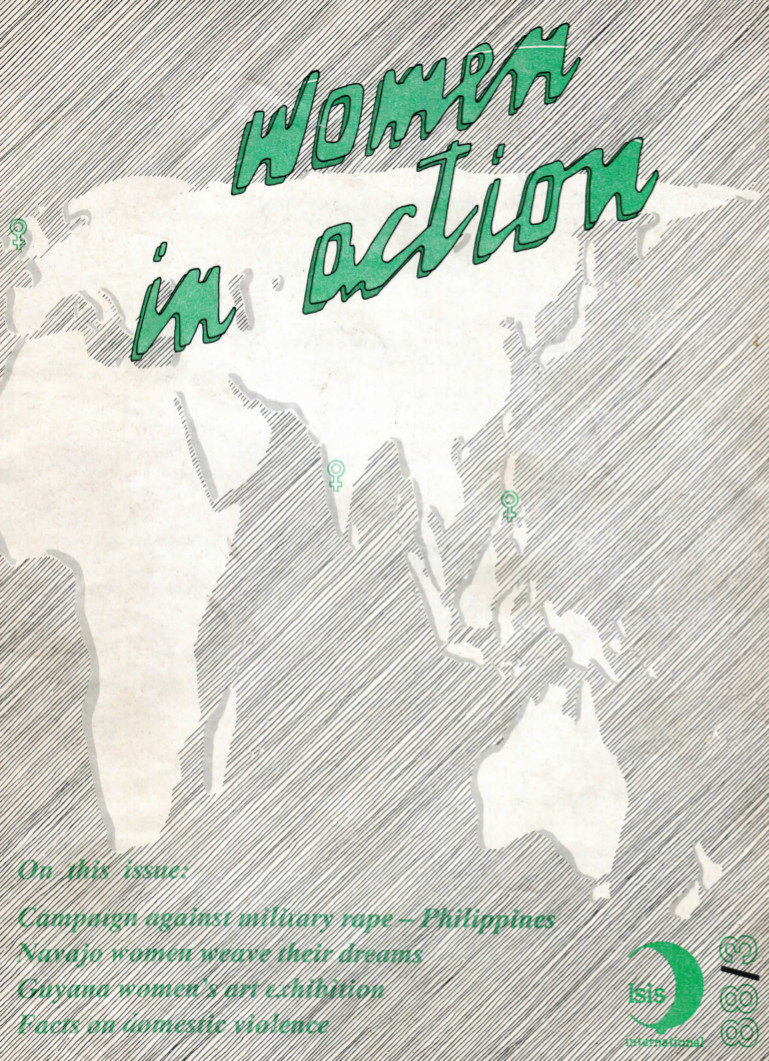 |
Editor: Niala Maharaj |
| Letters from our Readers | 2 |
| International Feminist Network | |
| Putting an end to military rape | 3 |
| Groups | |
| Making computers work for women | 6 |
| Tamil Nadu women's sangams | 29 |
| Work | |
| Navajo women: Weaving their dreams | 7 |
| Myth of the male provider | 9 |
| Culture | |
| Guyana: Homage to lost artists | 12 |
| Violence | |
| Facts of domestic violence | 13 |
| Poem | |
| Dreamshadows | 15 |
| Networking | |
| The necessity of networking | 18 |
| Poem | |
| Female Education | 21 |
| Shame | 21 |
| Conferences | |
| Human rights and women . . | 22 |
| Grassroots organizations . | 23 |
| Communication for community | 23 |
| Health | |
| Indian anti-alcohol movement | 24 |
| Science | |
| Mass murder of babies in India | 27 |
| Resources | |
| Asia and the Pacific | 31 |
| Europe | 32 |
| Canada and the USA | 33 |
| Africa and the Middle | 33 |
| Latin America and the Caribbean | 34 |
| International | 35 |
Asia and the Pacific
Daughters in Industry: Work Skills and Consciousness of Women Workers in Asia
edited by Noeleen Heyser, Asian and Pacific Development Centre, Pesiaran Data, P.O. Box 12224, 50770 Kuala Lumpur, Malaysia
A very comprehensive volume of case studies from ten countries in Asia. Bangladesh, China, Korea, Laos, Malaysia, Pakistan, the Philippines, Singapore, Sri Lanka and Thailand are all the focus of substantive studies by an impressive collection of scholars.
Topics covered include rural industrialisation and home-based production, labour-intensive industrialisation (covering, Bangladesh, Pakistan, Sri Lanka and Thailand), labour organisations and labour actions, and the impact of the shift to high technology on women in South Korea and Singapore.
The case studies are based on first hand research as well as historical, economic and sociological analysis. This is a most important book for those interested in the future of women workers as well as present realities.
Men, Women and Violence: A handbook for Survival
published by the Association of Women for Action and Research (AWARE) and the Singapore Association of Women Lawyers (SAWL) available from AWARE, Tanglin P.O. Box 244, Singapore 9124
A model publication. In every country, similar booklets should be produced and distributed throughout schools, colleges and communities.
This little book is extremely clear, well- organised and well- illustrated. It goes through all the forms of violence against women, rape, sexual harassment, incest, child abuse, etc., etc...
In simple language, point by point, it explains what acts fall under these titles and then what a victim or potential victim can do. At the back of the book is a long list of the agencies which can be called upon for help in different cases.
In each section, it explains both the legal and social aspects of the various topics, but m such an uncluttered way that makes comprehension very easy. It goes into the definition of the different offenses, the punishment established for them and the possible consequences for victims.
Humorous illustrations help to lighten an otherwise unsavoury subject, and encourage a positive attitude to the problem. This book was produced for the Task Force for the Prevention of Violence Against Women Singapore Council of Women's Organisations (SCWO) for their project Stop Violence Against Women.
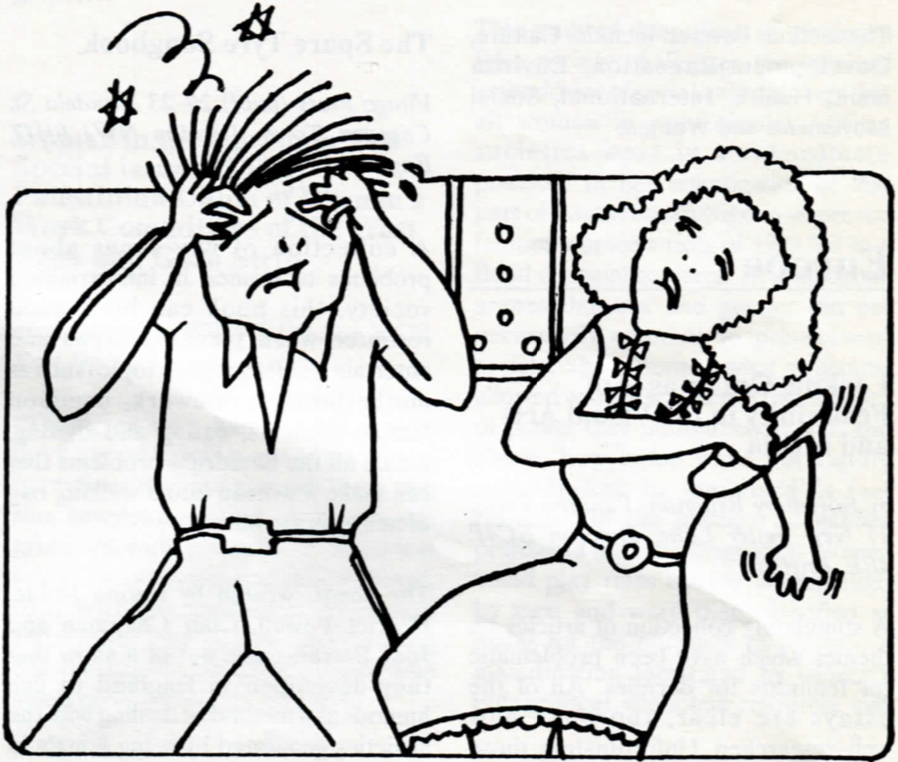
Sati, (special edition of Seminar journal)
available from P.O. Box 338, New Delhi-1, India
Sati (or widow immolation) is a phenomenon far removed from the experience of most people outside India. Like female circumcision in Africa however, it is a practice that sheds light on the nature of male-female interactions that seem much more benign.
This journal, containing contributions from noted scholars and activists in India, is well worth examination by non-Indians. When this single phenomenon of Sati is taken apart by the various skilled analysts, a very clear picture of the elements of modern Indian social life emerges.
Articles include one on Sati in history by renowned historian Romila Thapar, another on the politics of widow immolation by Sudesh Vaid, a third called Perpetuating the Myth, by Kumkum Sangari as well as a legal analysis entitled, Saint, Victim or Criminal by Vasudha Dhagamwar and a series of interviews with village women on the issue of sati. The introduction is by Kamla Bhasin and Ritu Menon.
The Other Picture: A Resource Guide to Audiovisual Material
published by CENDIT, D-1, Soami Nagar, New Delhi - 110017, India
This very valuable catalogue of material on alternative issues ranges far and wide but lists mainly films, videotapes and slide productions made in the third world. Because of the source, the focus is mainly on India, but the large number of useful productions listed make it clear that there exists a great deal of audiovisual material which can be very helpful to development groups, activists and educational institutions.
The sections covered include: Culture, Development,Education, Environment, Health, International, Social Movements and Women.
Europe
Looking On: Images of Femininity in the visual Arts and Media
by Rosemary Betterton, Pandora Press, 11 New Fetter Lane, London EC4P 4EE, England
A stimulating collection of articles on themes which have been problematic for feminists for decades. All of the essays are clear, thorough and well-researched. Unfortunately, those on advertising and pornography do not add much to our conceptualisation of these issues. However they are insightful and make the book a useful resource for teachers, workshop leaders and general readers.
The sections dealing with the visual arts are fresher; they probe into areas that are well worth exploration. In addition, the writing in all the pieces sparkles with intelligence and scholarship.
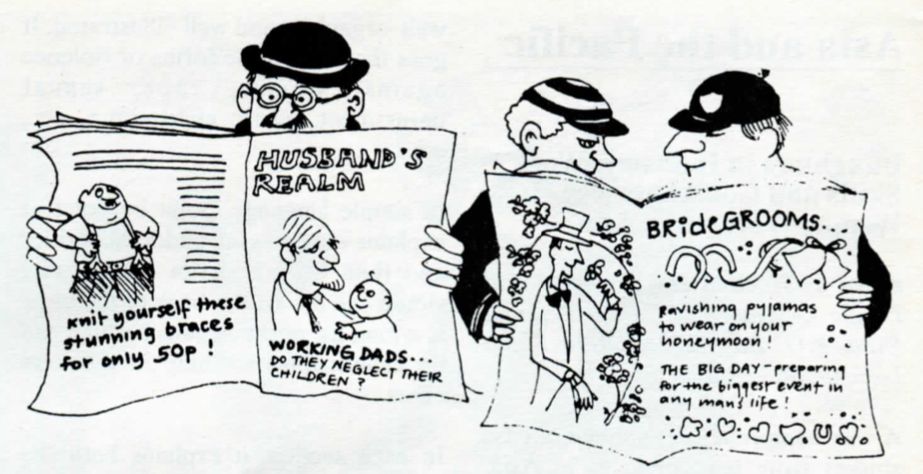
The Spare Tyre Songbook
Virago Press (publ) 20-23 Mandela St, Camden Town, London NWl OHQ, England
A collection of wry songs about problems of women in industrialised society, this book can be a good resource when planning shows and entertainments. Songs on topics such as motherhood, housework, common female ailments, eating and dieting, men... all the humdrum problems that can make a woman into a walking bag of neurosis are here.
The songs, written by Katina Noble, Harriet Powell, Clair Chapman and Judy Farrar, came out of a show that they developed in England to use humour as a method of dealing with the anxieties generated by being female in that kind of society. With the domination of Western media, far more of us may be susceptible to these pressures, so the Spare Tyre song book may turn out to be quite widely applicable.
Georgie Porgie: Sexual Harassment in Everyday Life
by Sue Wise and Liz Stanley, Pandora Press, 11 New Fetter Lane, London EC4P4EE, England
A very convincing book which puts the term sexual harassment under very close examination. The thesis is that this commonly- used phrase should not be applied only to incidents where sexual attentions are forced on unwilling women, but also to the mundane events of everyday life where women are constantly reminded of the role which they are expected to play, are manipulated or nagged or teased into compliance with their subordinate and trivialised status.
Slices out of everyday life are taken out and put under the microscope to demonstrate the consistent strain which is put on women to give in and accept the role which the folklore of industrial society has dictated for them. But the writers maintain that with vigilance women can keep up some resistance. A very readable book.
Canada and the USA
The Laughing Baby: Remembering Nursery Rhymes and Reasons
by Anne Scott, Bergin and Garvey Publishers, 670 Amherst Road, Granby, MA 01033, USA
A sweet little collection of nursery rhymes from all round the world. Translations and often music are provided as well as guide lines for their use in games and clapping activities.
What makes the book particularly valuable is the deliberate way it points attention to childcare traditions that are dying out in industrialised society. In a simply, but convincingly, written introduction, Scott explains the rationale for reverting to a form of upbringing that stresses touch, laughter and fun. A nice little gift for mothers.
The Sun is Not Merciful
By Anna Lee Walters, Firebrand Books, 141 The Commons, Ithaca, New York 14850, USA
Anna Lee Walters is a Pawnee/Otoe Indian, originally from Oklahoma, now living and working on the Navajo Reservation in Arizona. Her book of short stories, full of the flavours of Indian and North American life, speaks with a profound simplicity that conveys a precious humanity.
The influence of the oral tradition is strong, and the honesty of all the sights and sounds of an old, but now marginalised and pauperised people is deeply poignant. The sheer talent of the storyteller creates something beautiful out of whatever tawdriness exists and invites us with a subtle summons to marvel at glories now almost buried.
Africa and the Middle East
Sauti ya Siti (magazine)
Tanzania Media Women's Association PO Box 6143, Dares Salaam, Tanzania
A new magazine of this name has been launched by the Tanzania Media Women's Association. Taking its name from a woman singer/poet of Tanzania, who rose from humble beginnings to become a legend in the early years of this century, the magazine's aim is to provide a voice for the broad range of issues which affect Tanzanian women.
The first issue, 36 pages long, include a fascinating profile of its namesake, Siti, two articles on women workers, one on house girls (domestic servants), another on South African women, a short story, as well as a number of other items. Printed in black and white, it includes a number of photographs and graphics.
Women in the Uprising: Two Special issues of The Palestinian Union of Women's Work Committees of the West Bank and Gaza Strip
available from PFWAC, PO Box 20576, East Jerusalem, via Israel
"They may have hurt me but I gave them a good fight!"i s one of the typical quotations studded through these two slim newsletters. Much of the space is taken up with accounts of individual acts of resistance against military raids, told with the vividness of recent experience. The violence is horrifying but the bravery of these women who stand up to it is very impressive.
The Circumcision of Women: A Strategy for Eradication
by Olayinka Koso-Thomas, Zed Books Ltd, 57 Caledonian Road, London Nl 9BU, England
A very detailed 20-year programme for the eradication of female circumcision. Based on extensive research in Sierra Leone, this medical doctor has set down a thoroughly developed model which can be adapted to other countries. More than this, she includes a wealth of statistical material on the health effects of the practice. These, based on interviews and health records, can be powerful arguments in the swaying of the health establishment to take seriously the need for mounting campaigns.
Male Daughters, Female Husbands: Gender and Sex in an African Society
by Ifi Amadiume, Zed Books Ltd, 57 Caledonian road, London N l 9BU, England
This study of the politics of gender in Igbo society challenges the received orthodoxies of social anthropology that all women in pre-colonial African societies were in a subordinate position. In her investigation of that part of Southeastern Nigeria where the famous women's riots of 1929 led to a flood of social research, Ifi Amadiume argues that sex and gender did not necessarily coincide in pre-colonial society. She examines what structures allowed women to achieve the measure of power they undoubtedly did, and shows how roles were not rigidly masculinised or feminised (a fact reflected in the absence of gender prefixes in the Igbo language). Women could play roles usually monopolised by men and were then classified as males for the purposes of power - a classification facilitated by women's independent economic resources and the existence of a strong goddess-focussed religion.
The colonial period brought economic changes that undermined women's monopoly over the sale of certain foods and reduced the economic sanctions they could wield over men. The Christian Church attacked the goddess religion and those customs that enhanced women's status. And the colonial administration's appointment of male warrant chiefs and courts, reduced women's political roles.
In the modern period, Ifi argues that these patriarchal tendencies have continued and intensified. She outlines a series of basic changes whereby the continuing deterioration in Nigerian women's power and status can be reversed.
Latin America and the Caribbean
The Tiger's Milk: Women of Nicaragua
by Adriana Angel and Fiona Macintosh, Virago Press, 41 William IV Street, London WC2N 4DB
A beautiful book. Simply, the women of Nicaragua tell their stories: old women, young women, activists, teachers, organisers, mothers, labourers, Indians, blacks. They tell of the pre-revolutionary days, of hardship and deprivation, of their current and sometimes dire struggles, of determination, of hope and of survival. The honesty of the accounts is truly inspiring.
This looks like a simple book. But there has clearly been a very meticulous editing job, for the voices and personalities of this wide range of
women to emerge so clearly. The form of the book is excellent, short biographies accompanied by large black and white photographs in a very attractive format.
Lovely to thumb through over and over again, when your own spirits flag.
Cuando Trabajar es un Infierno: Las mujeres y la nueva division internacional del trabajo (2 volumes)
published by CIPAF, Benigno Filomeno Rojas No 307, Santo Domingo, Dominican Republic
A wonderful cartoon history of women as workers. Translated, the title of this series is: When work is a hell: Women and the new international division of labour. The drawings are truly excellent. It goes through the history of colonialism and conquest and then proceeds to modern capitalism and industrialisation and to new forms of international industrial organisation.
This series should be immediately translated into English and scattered by low-flying aircraft all over the Caribbean and the rest of Latin America. A fantastic educational tool.
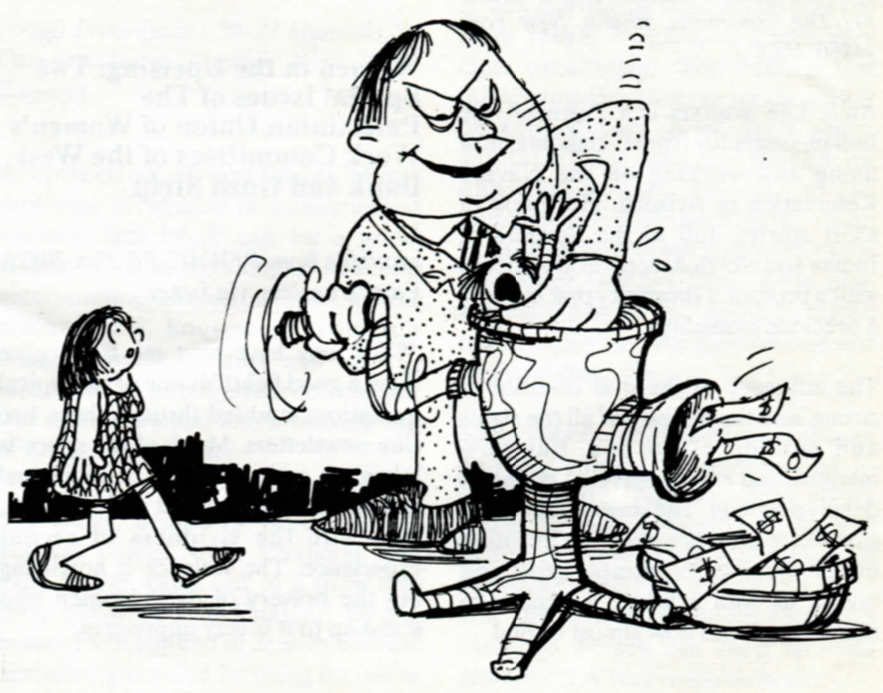
You Can't Drown the Fire: Latin American Women Writing in Exile
edited by Alicia Partnoy, Cleis Press, PO Box 8933, Pittsburg Pensylvania, USA
Stripped day by day Of all my garments, dry naked tree, m my solitary withered mouth fresh words will still blossom
by Alaide Foppa (disappeared)
It is difficult to write a notice about this book which is better than that which appears on the back cover. So here it is:
The voice of exile ricochets off endless walls, never losing its resonance or shattering the walls. And the surfaces which reproduce its powerful sound are the rock of natural canyons, the streets of strange cities, human skin, the heart's muscle. Exile: a painful phenomenon of our times. Women in exile: certainly the epicentre, those who so often receive the greatest weight while sustaining others - and themselves - in a maddening spiral of imposed change. I cannot think of anyone who could have done a better job of gathering up these voices: for Alicia Partnoy is, herself, very much a part of this history. Listen to these women: in essay, narrative, poetry, testimony, song. Learn, through their words, what it means to leave your homeland and take it with you at one and the same time.
Margaret Randall
International
Stopping Rape: Successful Survival Strategies
by Pauline B. Bart and Patricia H. O'Brien,The Pergamon Press, Headington Hill Hall, Oxford OX3 OBW, England
A must for activist women's groups. This book is based on a research project conducted in the USA which studied two groups of women who had been attacked by rapists. The women in the first group had actually been raped, those in the second had managed to avert the act. Through analysing the differences in behaviour of the intended victims, the researchers tried to isolate the behaviours that may have prevented the actual act of rape from taking place.
Going still further, the writers then investigated attitudes, cultural and religious backgrounds and a number of other factors in order to determine if there are determinants within socialisation practices which may precondition women to become rape victims.
The final result is a very suggestive piece of work which points to concrete ways in which women can be trained and oriented so as to prevent themselves being vulnerable to rapists. Only other trained social scientists can properly attest to the methodology employed. However, to the lay feminist applying mere commonsense, the material in this book looks like gold, teasing apart, as it does, all the conscious and unconscious questions that one battles with in one's lifelong preparation for the attack of the would-be rapist.
The essential message of the book is: Fight Back. True, you run the risk of injury, but the research shows that the dangers are often no greater than if you are passive. In addition, it appears, women who do fight back find it easier to recover emotionally m the long-term than those who don't.
Screaming, running away, physical resistance, verbal struggle, counterattack, negotiation... all these can be effective strategies, particularly if used together. What is crucial, however, is an alert, anti-panic mind-set, early recognition of danger and a strong sense of outrage against the attacker.
In the analysis of the case-histories of the attacked women, the authors found that those who had been socialised to fight their own battles and not to depend on having a rescuer at hand were the most successful in combating rape attacks. They found that women who had been encouraged to be involved in contact sports Uke football were far better equipped for such a situation, particularly when this was combined with strong appreciation of their rights to their own bodies.
Essentially, what was most important was the will not to be raped, though this cannot always protect a woman against a plurality of armed attackers.
Because Bart and O'Brien's study focuses so steadily on the concrete experiences of their subjects, the reader confronts situations which, in her normal life, remain in the realm of vague horrors. In calmly analysing the reactions of others, she can devise game-plans for possible danger-situations of her own. This book can be an invaluable basis for the preparation of self- protection training programs for women.
VDU Hazards Handbook: A worker's Guide to the Effects of New Technology
by Ursula Huws, London Hazards Centre, 3rd floor, Headland House, 308 Gray's Inn Road, London WCDCSDS
This is a publication that will be of value to the many women's organisations whose members use computer terminals in offices. Because computers are so important for so many tasks in today's world, there is a reluctance on the part of the establishment to recognise the possible health hazards that might exist for workers. The thousands of women all over the world whose typewriters have been exchanged for video display units must, therefore, insist that this is an important area for investigation.
The London Hazards Centre has made a creditable effort to further the work through the publication of this book. Based on the research that has been done so far, it looks at the way this new technology affects different organs and aspects of the worker's health. Particularly alarming is the statistics it offers on reproductive health. Clearly, for any woman who is pregnant or trying or hoping to become so, work at a VDU workstation is something to be avoided. For others, there is the clear need for conditionality to be attached to use. Length of time at the VDU, seating facilities, lighting, noise, all of these must be controlled.
The book refers to battles fought in various places to institute these controls and offers guidelines for workers to organise so as to insist on a proper working environment.
The book was written for British readers, but it is clearly relevant to women in offices all over the world.
The Revaluation of Women's Work
by Sheila Lewenhak, Croom Helm Ltd, Provident House, Burrell Row, Beckenham, Kent, BR3 lAT, England
A massive compilation of data on the value of women's work globally. Every conceivable fragment of women's existence is overturned to see if it sheds light on the issue, from dowry to water provision to put-out work to successful businesswomen in England..What the book lacks, however, is an introduction to give the reader assistance in going through the welter of information provided.
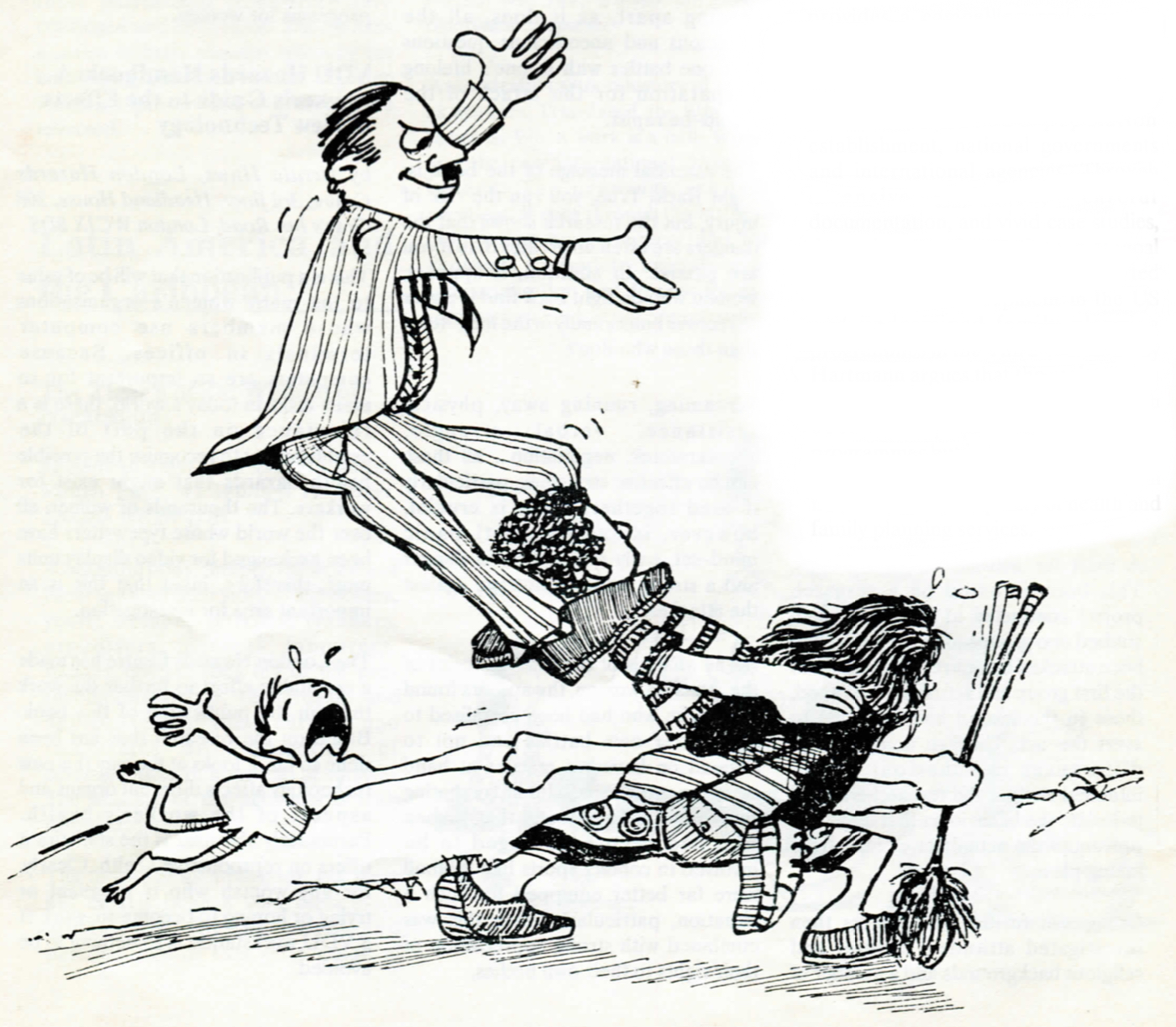
Reproductive Rights and Wrongs: The Global Politics of Population Control and Contraceptive Choice
by Betsy Hartmann, Harper and Row Publishers, 10 East 53rd St, New York, N.Y. 10022, USA
To quote an earlier commentator, the women's movement has been waiting for such a book for a long time. It provides a compelling and urgently needed critique of the economic, political, health and human rights consequences of population control as practiced by the US population establishment, national governments and international agencies. Through extensive research, careful documentation, and vivid case studies, the author reveals how the narrow goal of reducing birth rates has distorted contraceptive development in the US and undermined family planning programmes in the Third World. Betsy Hartmann argues that the real solution to the population problem lies not in coercive population control programmes but m the improvement of living standards, the position of women in society, and the quality of health and family planning services.
A Report from South India
Having had the common experience of growing up female in rural India, we had been brought up to view our bodies with suspicion and contempt, and this had given us a poor self-image. Having never understood the way our bodies functioned, we were ashamed of and feared its functions. Learning about our bodies has helped us develop self-respect and has given us a sense of power over our lives, and the confidence to challenge and change things around us. This is why our first step in working with other rural women was to be about Women and Health, and this, we believed, could eventually encourage women to play an active role in their communities and work to change their oppressed situation.
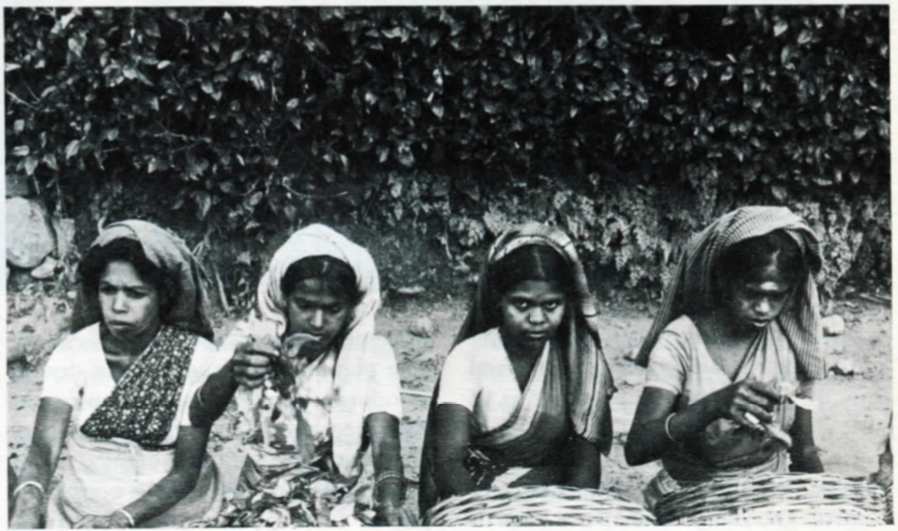
The women who constitute the Rural Women's Social Education Centre belong to the villages of Chingleput in Tamilnadu, South India. With the exception of just one, all of them belong to the harijan or untouchable castes, which is on the lowest rung of the traditional caste hierarchy. Each of them works as an animator in her own village, and is trained to perform a multitude of functions: health care, health education and advocacy, literacy
teaching and organising women. A doctor and a coordinator assist them in their work.
The animators provide basic health care to the villagers, with special attention to women. They examine and advise pregnant women and lactating mothers, monitor the growth of children and arrange for their immunisation regularly. They administer simple home remedies as far as possible. They have teamed-up with the traditional village midwife to conduct deliveries hygienically. They have helped village women understand their health problems and participate in their own healing, rather than being 'Messiahs' who can cure all illnesses.
The animators have set up a women's centre in each of their villages. It serves as a meeting place for women who get together late in the evenings, once the endless chores of the day are over. It is also a place to meet, talk, relax, discuss and learn. One evening a week is set aside for learning about health related problems that concern women. They have learnt about how their bodies function, about menstruation, pregnancy, child birth and birth control. They have discussed for hours the validity of many of the myths and taboos surrounding menstruation and child birth that still prevail.
Discussions on malnourishment have led to talking about the need for higher wages for the difficult agricultural work they do, since what they now earn can scarcely feed one person adequately. When we examined causes of diarrhea and dysentery the common killers of children under five, it became clear that their prevention is impossible without protected drinking water. This meant petitioning the authorities and we had to learn about procedures for this as well.
Another oft-discussed subject is birth control. The village women are keen to practise birth control and eager for information. One of their major problems is the right to choose a method of their choice. Contraception services are free in our hospitals, and in their anxiety to utilise their resources optimally, the hospital tend to stipulate who can avail of what to the extent that the woman concerned has hardly a say in the matter. The women from many of our villages brought this to the notice of higher authorities. Health issues are thus inextricably linked to the social, economic and political issues of the milieu, and challenging the one means challenging the whole.
Apat from the health related discussions there are also other meetings through which the women are participating in a process of developing their critical conciousness about the structures that oppress them. Role plays that portray the reality of their existence are a great favourite. After a role play on, for example, the double standards applying to women in the village community, or the way the poor are treated by the bureaucracy, or the way landlords use their economic power over poor women from the Harijan castes from sexual exploitation, the women's centre comes alive with voices of women. Everyone participates in talking about the characters portrayed in the roleplays and eventually comes to see how it is related to her own life. At times the animator reads to the women stories, anecdotes and case studies depicting lives of poor women like them or instances where women have actively confronted the system and tried to change it.
The women's centres have helped in the consolidation of women's groups in these villages and led to the creation of women's sanghams (associations) with the members paying a small membership fee of 50 paisa. This amount subsidizes the cost of medicine dispensed and a part of it is set aside as savings. The women's sanghams are taking an active part in the affairs of their respective villages. They have organised to demand higher wages in some villages, with success. Their untiring efforts to secure drinking water taps was rewarded in one village. They are alert, and take preventive measures against epidemics. They act as a pressure group to secure what is rightfully due to them from the powers that be.
Women from different village sanghams meet in workshops organised thrice a year. Each of these wokshops has a particular theme. A wide range of themes have been taken up so far: political parties and their ideologies, Panchayat (village council) elections, development plans of the government, group dynamics, public speaking, problem solving techniques, to mention a few.
They say:..our beginning to relate to our society through the women's movement has given a central unity to our lives; we are no longer drifting, relating passively to life; rather we are attempting through an intensive relationship to society to affect history, to act instead.
by Vibhuti Patel, Women's Centre, Bombay
Amniocentesis is a scientific technique that was intended to be used in detecting genetic abnormalities of a foetus. In India, it is currently being widely used as a means for sex determination. By comparison to other countries, amniocentesis is quite expensive in India. Yet, not only upper class women, but even working class women have access to the test. A recent survey of the slums in Bombay revealed that when women found out their foetus was female, many chose to abort. Many argued that it was better to spend a bit of money now for an abortion than have to pay a fortune for a girl's future marriage.
The controversy began a few years ago when the results of several investigative reports were published in popular Indian magazines and journals. Many of the results were horrifying. Of 8,000 abortions following amniocentesis, 7,999 were found to involve female foetuses. In addition, between years 1978 and 1983, it is estimated that 78,000 female foetuses were aborted after sex- determination tests m India.
The government and private practitioners involved in this lucrative trade justify the sex-determination test as a measure for population control. Women have always been the ones burdened with the effects of family planing practices. Harmful effects of pregnancy tests, contraceptive pills, anti-pregnancy injections, and unhygienic camps for mass sterilisation of women are just a few of the drawbacks often overlooked by enthusiasts of family planning policy.
Large and steady decline in the female/male ratio this century
India has a history of killing female children (dudhapiti) by putting opium on the mother's nipple, by putting the afterbirth over the child's face, and by ill-treating its daughters. Even today. Between 1971 and 1981, there was a marginal increase in the ratio, although women are still outnumbered by men. India is one of the few countries where the female-to-male ratio is declining. Economists often say that if the supply of women is reduced, women's status will be enhanced.
According to this logic, women won't be burnt alive because of insufficient dowry because they won't be an easily replaceable commodity. But the economists forget the socio-cultural female members of the family get inferior treatment as far as food, medication, and education is concerned. When a girl grows up, she is further harassed about her dowry. Many social scientists ask whether or not it is better to die rather than be ill-treated. In the words of Dharam Kumar, "Does the birth of...millions of unwanted girls improve the status of women?" To think that it is better to kill a female child or foetus than to have a child whose sex is not highly valued in society is fatalistic. Next, people will rationalize that it is better to kill the poor rather than let them suffer poverty and deprivation! How horrifying!"
But what can be the long-term implications if such trends continue? Won't it further aggravate the already disturbed sex— ratio? There was a large and steady decline in the female/male ratio in India between 1901 and 1971. milieu in which women have to live. A society that treats women as mere sex objects will not treat women in a more humane way just because they are in scarce supply. On the contrary, in many local communities, there is a negative correlation between the female/male sex ratio and the incidence of rape, abduction and forced polyandry.
Another argument in favor of sex-determination tests is one which touts the myth of the ideal "balanced family". It is argued that women who have one or more daughters should be allowed to abort their daughters and try again to produce a son. This concept of "balanced family" is extremely sexist and very frightening. Would a couple undergo amniocentesis to get rid of a male foetus, just so that they could have a daughter in order to balance their family? No, never!
Time and again it is stated that women themselves enthusiastically go for the test out of their own free will. "It is a question of a woman's choice." But, are these choices made in a social vacuum? Indian women are socially conditioned to believe that unless they produce one or so male children, they have no social worth. They are harassed, taunted, and even deserted by their husbands and in-laws if they fail to produce a male child. Thus, their 'choices' are limited by their fear of ridicule by society.
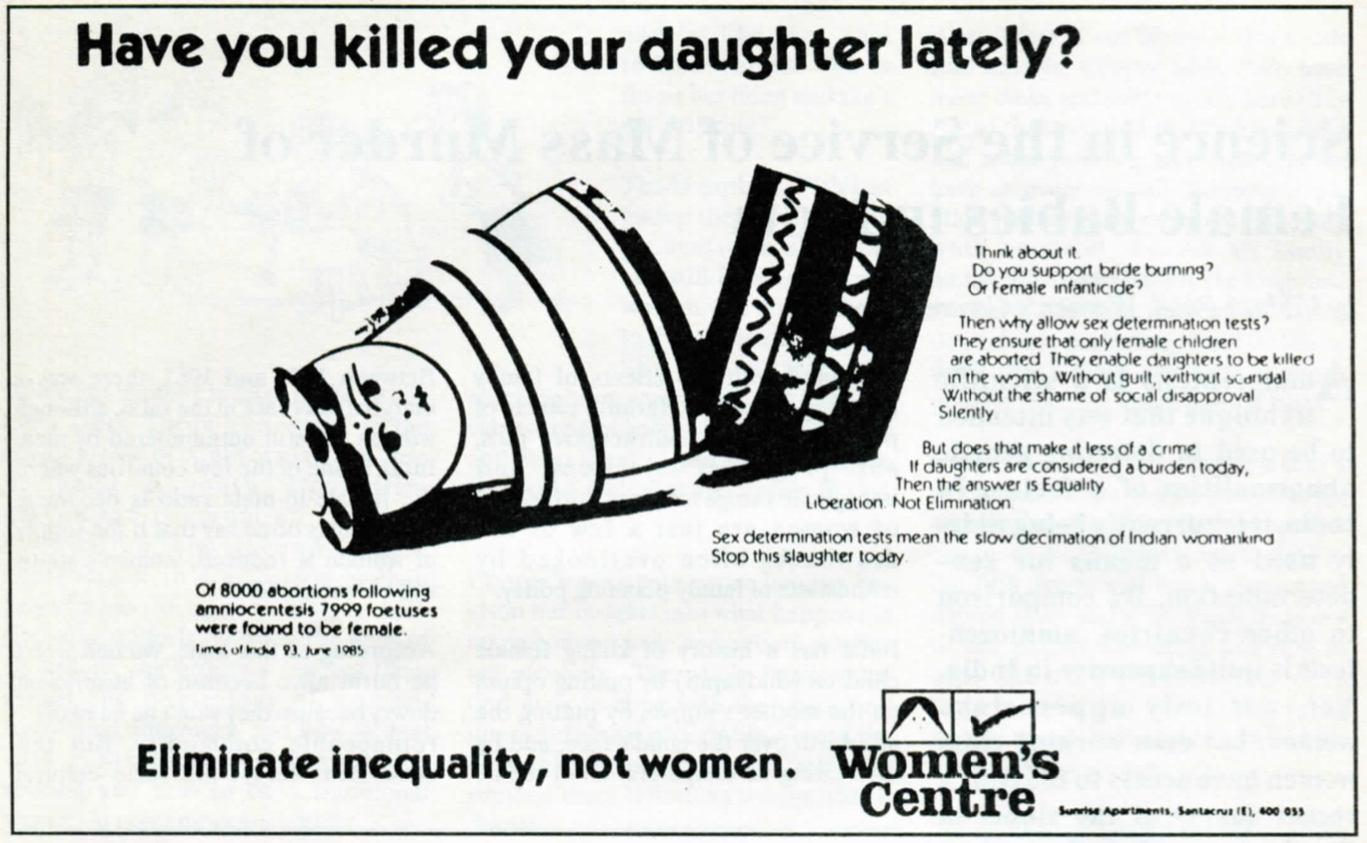
It is true that feminists all over the world demanded the right of women to control their own bodies and choose whether or not to have children. They have also fought for free, legal and safe abortions. But these issues should be viewed in a different context in Third World societies because imperialism and racism are often major forces working to control coloured populations. Population control advocates often endorse women's rights and then divert attention from the real causes of the population problem: lack of food, economic security, clean drinking water and safe clinical facilities. These factors have created a situation where women must have between two and six children in order to have at least one surviving male child. This is the root of the population problem.
Abuse of amniocentesis shatters the myth of the neutrality of science and technology. Just as the invention of atomic energy was used to destroy Hiroshima and Nagasaki, so could sex determination tests be used for female extermination.
We at the Women's Centre are undertaking educational campaigns to help combat this problem. Most women's groups feel that amniocentesis should be permitted only under strict governmental control and only for the detection of genetic abnormalities. To consistently campaign against the notorious activities of money-minded doctors and the antipathy of the government, the Forum Against Sex-Determination and Sex Pre-selection was formed in Bombay in 1986. As a result, this issue has gained nationwide publicity and the government has begun to respond favourably. In March 1987, a committee was appointed to study the proposal to stop the misuse of sex-determination tests. We are hopeful that the government will help to prevent the situation from leading to further female extermination.
For further information, contact:
Women's Centre 104B Sunrise Apt., Above Canary Bank Nehru Road, Vakola Santacruz (East), Bombay 400 055 India
Source: Connexions, Winter 1987
Alcoholism is a disease that affects all family members and crosses generations. Throughout the United States, a movement toward recovery and freedom from alcohol and drugs is occurring. This is also happening in Indian Country. In Oakland, California, two Blackfeet women, mother and daughter, are at the apex of this new Indian movement. Betty Cooper is director of the Native American Alcoholism Program and her daughter Theda New Breast is a pioneer in the field of Fetal Alcohol Syndrome prevention.
Betty Cooper has been working in the Bay Area Indian community for many years. It was during her years as a social worker that she first experienced the effect that alcohol was having on the Bay Area community. She believes that most of the problems that families confronted then originated from alcoholism in the family.
It was while working at Inter-tribal Friendship House in Oakland that she saw the devastating result of alcoholism from people who didn't have food, babies with no milk, no gas for the car, no place to live, evictions, teenage problems and every type of health problem. She next worked for the Urban Indian Child Resource Center, also in Oakland, where she says, "We had child abuse and neglect, we had more neglect than abuse. It was probably
99% alcohol related."
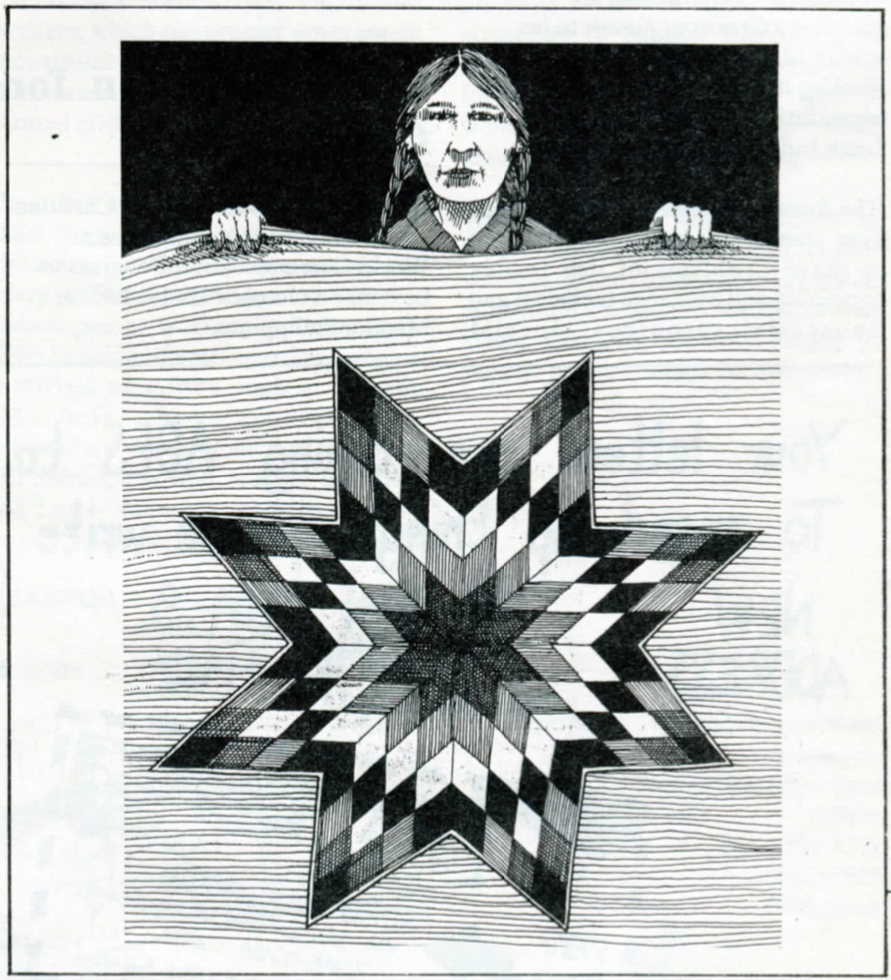
She recalls that it was in the 1950s when alcohol was no longer restricted from the reservation that it began to be sold openly. The results were immediate and devastating. It seemed that everyone began to drink including grandmothers who had never used alcohol. Small children were left sitting outside the bars crying for their parents who were inside drinking. Even babies
were left alone in cars while the parents drank. She saw a pattern of arrests, spouse battering and fragmented families emerge as a result of alcohol. Within her own family her brothers developed severe drinking habits and the problems that came with it. After she and her husband moved to California he also became an alcoholic.
After what she had seen and experienced personally she decided to become involved in the field of alcoholism treatment, recovery and prevention.
Theda New Breast has been involved m the field of Fetal Alcohol Syndrome (FAS) prevention and education for ten years. She focuses her attention on women and youth. FAS, she says, is very high among Indian women. "In some Indian communities it is seen in as many as one in 100 births."
Fetal Alcohol Syndrome is a birth defect that is caused by drinking alcohol during pregnancy. It is probably the second most common birth defect and probably the number one cause for mental retardation. FAS manifests itself in both physical and mental development delay. Facial deformities and deformities of the limbs, heart and central nervous system are often FAS related.
According to New Breast, FAS is 100% preventable and 0% curable. A woman does not have to be alcoholic to have an FAS child. There is no known "safe" level of alcohol consumption for a woman while pregnant.
She also stresses that, "Indian women have been ignored in alcohol literature. Alcohol abuse has become the single most serious health problem
accounting for the five leading causes of death among American Indians."
Her involvement began, she says, when she was in her teens. "I am an ACA (adult child of an alcoholic). I went to Alateen and I found out my father had a disease. He wasn't just a mean person who beat us up. I said, 'that won't happen to me'. Of course, it did and I got into recovery."
It was ten years ago when she saw many studies that pointed out that most women who are pregnant spontaneously decreased their alcohol consumption. Practicing alcoholics cut down and social drinkers quit. "I saw that this was the Creator's way of taking care of children. And I saw that pregnant women were a prime source for intervention."
New Breast has developed an innovative training program and begins with training the trainers. She and her staff have put together a training manual that has an Indian focus, talks about Indian culture and tells any kind of caregiver or community person ideas on what to do about FAS education, how to put on a demonstration in one's own community.
"We try to get them involved because they are the ones who are making critical decisions over Indian people with either incarceration or taking the kids away or whatever. They need to know about Indian people and we try to sensitize them."
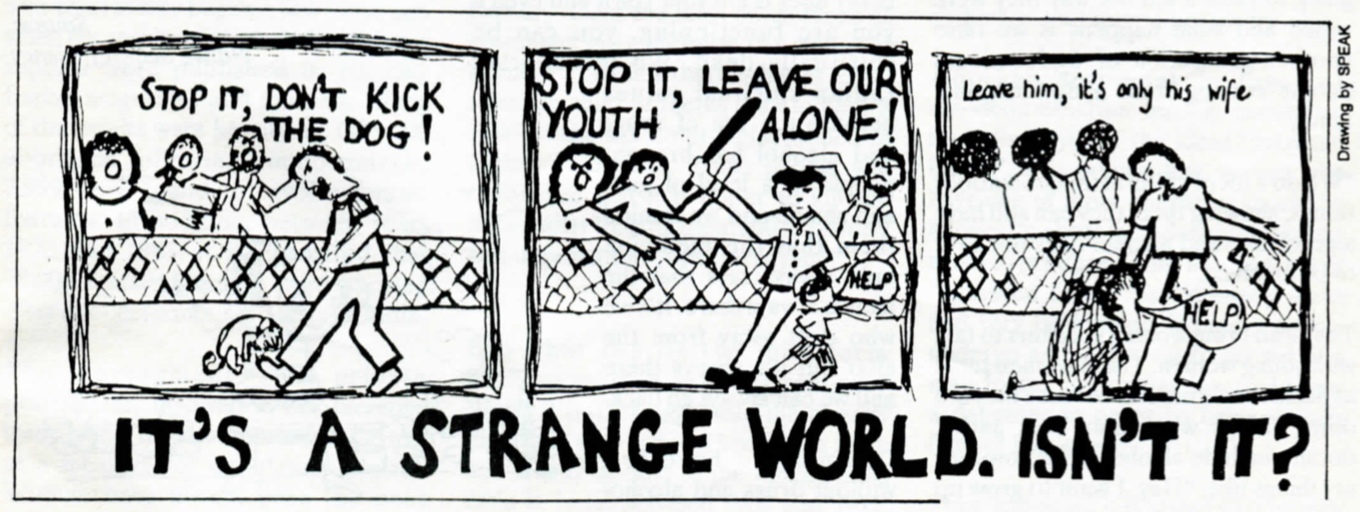
The overall purpose of the three day training cycle is to provide personnel of the Indian alcoholism programs, Indian youth and other key gatekeepers in California with the knowledge and tools to conduct training seminars on the prevention of alcohol related problems with the emphasis on Fetal Alcohol Syndrome and Fetal Alcohol Effects (FAE).
One of the innovations introduced by New Breast is the requirement that each trainee who attends a session must sign an agreement to return to the community and train a minimum of 25 people in whatever they consider to be their community. New Breast says, "This has been real successful because it's a pledge they make within themselves. We've got people out there diligently training in their communities."
She has used FAS as a way to open the door to talk to Indian communities about addiction, but her primary focus is FAS. While her mother is busy in the urban inner cities Theda also works in the rural areas of California. She has designed a youth alcoholism prevention program on the Tule reservation, the second largest reservation in California with a population of approximately 650. Focusing on girls between the ages of 11 and 19, the program teaches them about the physiology of women, traditional midwifery, and how to deal with contemporary issues, choice making and how to be a traditional woman in contemporary society.
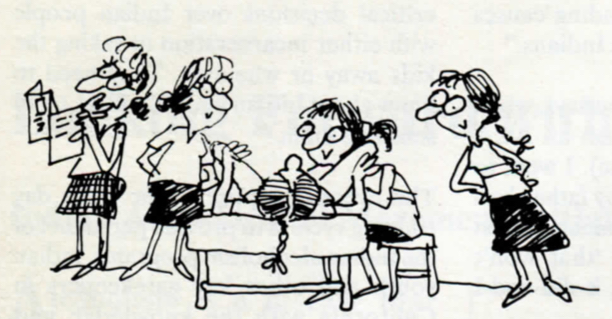
"A lot of the choice making is just simple skills. It is teaching our young women the ideas of support system, especially for raising kids. I try to help them understand that anyone can have kids but that doesn't mean they have parenting skills. Especially if they come from an abusive family background, a dysfunctional family. Then they are going to raise a kid the way they were raised and what happens is we raise another generation of dysfunctional people coming from a dysfunctional family."
"We do a lot of cultural things, outdoor things, showing them they can still have a good time and alcohol does not have to be involved."
They also bring women speakers to talk with young women. These women serve as positive role models because they are doing things with their lives and it doesn't include alcohol. And now they say things like, "Hey, I want to grow up and be like that, that Indian woman who is doing her thing and she's not drinking."
Theda explains, "It's just letting them explore and not limit themselves. She can still be a traditional woman, she doesn't have to live on the reservation. She can live in contemporary society but still have the values and beliefs that are traditional and keep them sacred and operate in the world and raise her family in that manner."
Cooper's work with entire families has given her insights into what happens in many homes where one or both parents are alcoholic. The whole family must find ways to cope with the chaos and unpredictability of daily life. One of the ways this coping manifests itself is to pretend there is nothing wrong. This is denial.
Cooper adds, "You know there is family denial but our communities also deny that there is an alcohol problem and I think our communities have to begin to look at themselves and how they enable their parents, children, grandparents.
Cooper says, "In alcoholism, what it really does is kill your spirit and even if you are functioning, you can be spiritually dead. We incorporate Indian spiritual values because the use of drugs and alcohol has brought people to a level of guilt and shame and we remind them that the medicine man always says that the altar is always there. It's we who drift away from the altar but it's always there and we can always go back.
Learning to have fun without drugs and alcohol is an aspect of our lifestyles that needs role models. Cooper adds, "We have more clean and sober events here (Bay Area) than we used to. We have clean and sober powows, and each year we have an event we call 'Running is My High' and we invite everyone out to run, walk or stroll, we ask all family members to come back to the lodge and we have a brunch. Instead of saying don't drink, don't drug, don't do this or don't don't don't, we have a strong positive message about natural highs."
Cooper has hope for a future where a whole generation will be free of drugs and alcohol. She says, "Right now, if we can reach the children from the third to the fifth grade and teach them some coping skills and if we teach them not to use alcohol and drugs and how to cope with it if it's at home, then we're looking at the year 2000 having young people, young Indian people, who have never used or abused.
We're looking toward having a whole generation of Indian people who don't feel that they have to be chemically dependent. We have to look at the overwhelming problems of alcoholism in our communities but we also have to look forward with hope."
Source:
Native Self-Sufficiency


